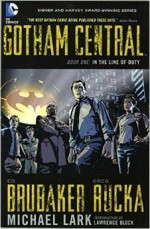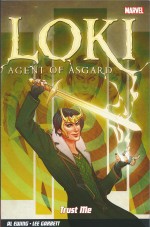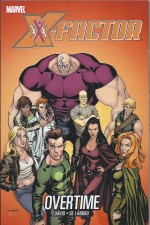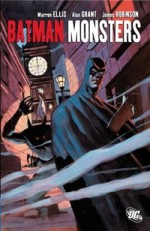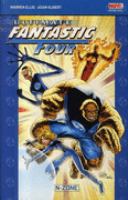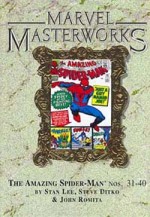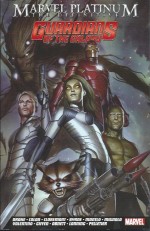
By Arnold Drake, Chris Claremont, John Byrne, Bill Mantlo, Jim Valentino, Keith Giffen, Dan Abnett & Andy Lanning, Gene Colan, Mike Mignola, Timothy Green, Paul Pelletier & various (Marvel/Panini UK)
ISBN: 978-1-84653-601-4
With another Marvel filmic franchise kicking off around the world, here’s a timely tie-in trade paperback collection designed to perfectly augment the cinematic exposure and cater to movie fans wanting to follow up with a comics experience.
Part of the always rewarding Marvel Platinum/Definitive Edition series, this treasury of tales reprints intriguing landmarks and key moments from Marvel Super Heroes #18, Marvel Preview #11, Rocket Raccoon #1-4, Guardians of the Galaxy volume 1, #1, Annihilation Conquest: Star-Lord #1-4 and Guardians of the Galaxy volume 1, spanning January 1969-July 2008, and hopefully answering any questions the silver screen story might throw up whilst providing an immense amount of spectacularly bombastic fighting fun.
One thing to recall at all times though is that there are two distinct and separate iterations of the team. The film concentrates on the second but there are inescapable connections between them so pay attention here…
Moreover, in addition to the sparkling Brady Webb Foreword, this compendium contains text features detailing the secret history and statistics of Drax, Gamora, Groot, Rocket Raccoon and Star-Lord, plus Mike Conroy’s scholarly trawl through comicbook history in ‘The True Origin of the Guardians of the Galaxy’.
Although heralded since its genesis in the early 1960s with making superheroes more realistic, The House of Ideas has also always maintained its close connection with outlandish and outrageous cosmic calamity (as best exemplified in their pre-superhero “monster-mag†days), and their pantheon of much-travelled space stalwarts maintain that delightful “Anything Goes†attitude in all of their many and varied iterations.
This titanic tome’s blistering battle-fest begins with ‘Guardians of the Galaxy: Earth Shall Overcome!’ first seen in combination new-concept try-out/Golden Age reprint vehicle Marvel Super Heroes #18 (cover-dated January 1969). The terse, gritty episode introduced a disparate band of freedom fighters battling to save Earth from occupation and humanity from extinction at the scaly hands of the sinister, reptilian Brotherhood of Badoon.
It all starts when Jovian militia-man Charlie-27 returns home from a six month tour of scout duty to find his entire colony subjugated by invading aliens. Fighting free, he jumps into a randomly programmed teleporter and emerges on Pluto, just in time to scotch the escape of crystaline scientist Martinex.
Both are examples of human genetic engineering: subspecies designed to populate and colonise Sol system’s outer planets but now potentially the last of their kinds. After helping the mineral man complete his mission of sabotage – blowing up potentially useful material before the Badoon can get their hands on it – the odd couple set the teleporter for Earth and jump…
Unfortunately the invaders have already taken the homeworld.
The Supreme Badoon Elite are there, busily mocking the oldest Earthman alive. Major Vance Astro had been the world’s first intersolar astronaut; solo flying in cold sleep to Alpha Centauri at a fraction of the speed of light.
When he got there 1000 years later, humanity was waiting for him, having cracked trans-luminal speeds a mere two centuries after he took off. Now he and Centauri aborigine Yondu were a comedy exhibit for the cruel reptilian conquerors who were eradicating both of their races…
The smug invaders were utterly overwhelmed when Astro broke free, utilising the psionic powers he had developed in hibernation before Yondu slaughtered them with the sound-controlled energy arrows he carried.
In their pell-mell flight the pair stumbled across the incoming Martinex and Charlie-27 and a new legend of valiant resistance was born…
The eccentric team, as originally envisioned by Arnold Drake, Gene Colan & Mike Esposito in 1968, were presented to an audience undergoing immense social change, with dissent in the air, riot in the streets and with the Vietnam War on their TV screens every night.
Perhaps the jingoistic militaristic overtones were off-putting or maybe the times were against the Guardians since costumed hero titles were entering a temporary downturn, but whatever the reason the feature was a rare “Miss†for Marvel and the futuristic freedom fighters were not seen again for years.
They floated in limbo until 1974 when Steve Gerber incorporated them into some of his assigned titles (Marvel Two-In-One and The Defenders), wherein assorted 20th century champions travelled a millennium into the future to ensure humanity’s survival. Rejuvenated by exposure the squad rededicated themselves to liberating star-scattered Mankind, and eventually gained a short-lived series in Marvel Presents (#3-12, February 1976-August 1977, but not represented here) before cancellation left them roaming the Marvel Universe as perennial guest-stars in such cosmically-tinged titles as Thor, Marvel Team-Up, Marvel Two-in-One and most significantly The Avengers.
In June 1990 they secured a relatively successful relaunch (#62 issues + annuals and spin-off miniseries) before cancellation again claimed them in July 1995.
However before we get there this volume highlights two seemingly unrelated characters who made their debuts elsewhere in the 20th century Marvel Universe.
Starlord (without the hyphen) premiered in black-&-white mature-reader magazine Marvel Preview # 4 in 1976, appearing thrice more – in #11, 14 and 15 – during the height of the Star Wars inspired Science Fiction explosion.
Years previously a warrior prince of an interstellar empire was shot down over Colorado and had a brief fling with solitary Earther Meredith Quill. Despite his desire to remain in idyllic isolation, duty called the starman back to the battle and he left, leaving behind an unborn son and a unique weapon…
A decade later, the troubled boy saw his mother assassinated by alien lizard men. Peter Jason Quill vengefully slew the creatures with Meredith’s shotgun, before his home was explosively destroyed by a flying saucer.
The orphan awoke in hospital, his only possession a “toy†ray-gun his mother had hidden from him his entire life. Years later his destiny found him, as the half-breed scion was elevated by the divinity dubbed the “Master of the Sunâ€, becoming StarLord. Rejecting both Earth and his missing father Peter chose freedom, the pursuit of justice and the expanse of the cosmos.
In his second outing (Marvel Preview #11, Summer 1977) Chris Claremont, John Byrne & Terry Austin crafted a classic space opera which saw the deity-appointed galactic policeman scupper a slaving ring and follow a string of clues back to his own incredible origins.
Presented here in the original monochrome, that tale opens on decimated agrarian planet ‘Windhölme’ where fisherman’s son Kip sees his entire community abducted like cattle by alien criminals. Aboard their vessel he is befriended by feisty fellow abductee Sandy but before they can enact their childish dreams of revenge the slaver dreadnought is attacked by Starlord and his sentient super vehicle “Shipâ€â€¦
The traffickers are no match for the aggrieved heroes and, after the victims have been repatriated, psychic interrogation leads Kip, Sandy and the stellar paladin up the criminal chain to flesh-peddler and imperial favourite Kyras Shakti on his debauched pleasure world ‘Cinnibar’.
The monolithic battle there reveals even greater Royal involvement, drawing Starlord to ‘Sparta’, and a shocking family connection before ‘The Hollow Crown’ sees Quill uncover his true origins when he is unexpectedly reunited with his alien father. Despite renewed emotional ties the hero forswears a life of impossible luxury for the heavens, duty and justice…
Rocket Raccoon was a minor character who appeared in backup serial ‘The Sword in the Star’ (Marvel Preview #7 in 1976). He won a larger role in Incredible Hulk #271 (May 1982), and like Wolverine years before refused to go away quietly.
Reprinted here in its entirety is the 4-issue Rocket Raccoon miniseries (cover-dated May to August 1985 and crafted by Bill Mantlo, Mike Mignola, Al Gordon & Al Milgrom), a bizarre and baroque sci-fi fantasy which blended the charm of Pogo with the biting social satire of One Flew Over the Cuckoo’s Nest all whilst ostensibly describing a battle between Good and Evil in a sector of space crazy even by comicbook standards.
Rocket was one of many talking animals in the impenetrable, inescapable Keystone Quadrant; a Ranger in charge of keeping the peace as robots and anamorphic beasties went about their holy tasks of caring for the distinctly odd and carefree humans known as The Loonies on their idyllic, sybaritic planet Halfworld.
However when a brutal shooting war between voracious apex toymakers Judson Jakes and Lord Dyvyne led to Rocket’s girlfriend Lylla Otter being kidnapped, the planet went wild, or perhaps… ‘Animal Crackers’.
In rescuing her, Rocket and his faithful deputy Wal Rus had to contend with a murderous army of mechanised Killer Clowns, face an horrific, all-consuming bio-weapon at ‘The Masque of the Red Breath’, and even team up with arch-foe and disreputable mercenary bunny Blackjack O’Hare before uncovering the horrendous truth behind the mad society he so tirelessly defended in ‘The Book of Revelations!’
The final chapter then shook everything up as ‘The Age of Enlightenment’ saw the end of The Loonies, allowing the Raccoon and his surviving companions to escape the confines of the eternally segregated Keystone Quadrant into the greater universe beyond…
Back on Earth, a speculator-fuelled boom in comics sales led to Marvel launching a bunch of new titles in the early 1990s. Amongst them was Guardians of the Galaxy volume 1, #1, once again focusing on the 31st century centurions.
Conceived, written and drawn by Jim Valentino – with Steve Montano inking – the debut issue reprinted here reprised the entire eccentric combined careers of Vance, Yondu, Charlie and Martinex (plus later recruits Mercurian Nikki and Starhawk – an alien god who shared a single body with his estranged wife Aleta) as the team set off on a quest.
They were following a string of ancient clues to recover Captain America‘s legendary shield, only to fall foul of cyborg-enhanced warrior ‘Taserface!’
For the rest of that epic journey and their battle against the alien Stark race who had based their entire warrior culture on Iron Man‘s armour, you’ll need to track down one of the many other GotG collections flooding out now…
In 2006 a massive crossover involved most of Marvel’s 21st century space specialists in a spectacular Annihilation Event, leading writing team Dan Abnett & Andy Lanning to confiscate and reconfigure the Guardians concept for modern times and tastes.
Among the stalwarts in the big event were Silver Surfer, Galactus, Firelord (and other previous heralds of the world-eater), Moondragon, Quasar, Star-Lord, Thanos, Super-Skrull, Rigellian Colonizer Tana Nile, Gamora (“Deadliest Woman in the Galaxyâ€), Ronan the Accuser, Nova, Drax (the Destroyer), a Watcher and many previously established alien civilisations such as the Kree, Skrulls, Xandarians, Shi’ar et al., all falling before an invasion of rapacious Negative Zone bugs and beasties unleashed by insectoid horror Annihilus..
After that shooting match subsided the decimated sectors and empires were left helpless as sentient, aggressive all-subsuming technological parasite The Phalanx struck, absorbing and thriving inside all the machines and electronic engines the shaken civilisations were using to rebuild in a follow-up apocalypse designated Annihilation: Conquest.
From that second sidereal saga came the beginnings of the Guardians the world has gone crazy over – specifically the side-bar miniseries Annihilation Conquest: Star-Lord #1-4 from September-December 2007 and which is reprinted here in full.
What You’ll Need to Know: in the scarred and war-torn realm of known space, still reeling from the chaos of the Annihilation Wave and its aftermath, both the Kree and Skrull empires are splintered, Xandar‘s Nova Corps (the universal police force) has been reduced to a single agent, ancient gods are loose and a sizable number of the Negative Zone invaders have tenuously established themselves in territories stolen from the billions of dead sentients that once populated the cosmos.
The Supreme Intelligence is gone and arch-villain Ronan has become a surprisingly effective ruler of the Kree remnants. Cosmic Protector Quasar is dead and Phyla-Vell, daughter of the first Captain Marvel has inherited both his powers and name…
Whilst Phyla and psychic demi-goddess Moondragon were working with the pacifist Priests of Pama to relieve the suffering of starving survivors, Peter Quill (no longer Star-Lord) was working with Ronan and the pitiful Kree remnants on Hala to shore up the battered communal interstellar defences of the myriad races in the sector.
Quill had brokered an alliance with the Spaceknights of Galador (an old noble cyborg species most famously represented by 1980s hero Rom) which should enhance the all-pervasive etheric war-net, but once uploaded the data instantly causes disastrous problems throughout the system.
In seconds all technology in the region is compromised: overruled and overwritten by a ruthlessly efficient electronic sentience whose cybernetic credo is “peace and order through assimilationâ€. Once more organic life is facing total extinction…
On Pama, Phyla and Moondragon are targeted by repurposed Kree automatons as the Phalanx attempt to destroy any credible resistance before cutting off the entire quadrant from the rest of the universe.
If life was to survive this threat it must besaved by the champions trapped inside…
The 4-part miniseries Annihilation Conquest: Star-Lord – written by Keith Giffen and illustrated by Timothy Green II, Victor Olazaba & Nathan Fairbairn, finds the former Cosmic Avenger stripped of his powers and hi-tech enhancements – all liabilities when facing a predator species that infests electronic devices – and forcibly seconded to a Kree resistance division.
Here he is tasked with turning a bunch of Kree convicts into a Penal Strike Force (a highly engaging intergalactic Dirty Half-Dozen) to take out the complex where the Phalanx are perfecting an efficient way to assimilate organics into their electro-mechanistic hive-mind.
The Kree were once the major bad-guy race in the Marvel mainstream, so whoever they consider criminals look surprising like failed heroes to us. Firstly there’s Galactic Warrior Bug (originally from 1970’s phenomenon Micronauts), the current Captain Universe (ditto), the Shi’ar berserker Deathcry, failed Celestial Madonna Mantis, the so-very-far-from-home Rocket Raccoon and gloriously whacky “Kirby Kritter†Groot: a Walking Tree and one-time “Monarch of Planet X.â€
With this reluctant team in tow and using natural abilities and decidedly primitive Earth weapons the squad invades Hala – central beachhead of the Phalanx – to discover and destroy the augmented assimilation project, but they have drastically underestimated the remorselessly callous creativity of the electronic invaders…
Happily the Phalanx have no grasp of the ingenuity, bloody-minded determination and willingness to die stupidly for a cause that afflicts organics and heroes…
Sharp, witty and engaging, this is a magnificent romp full of humour, shocks and thrills no comic fan could possibly resist…
The roaring success of all that intergalactic derring-do led to a new rootin’, tootin’, blaster-shootin’ conclave of outer space reprobates who formed a new 21st century iteration and this titanic tome concludes its comics cavalcade with Guardians of the Galaxy volume 2, #1, (July 2008) wherein some of those recently acquainted adventurers get back into the business of saving the universe…
‘Somebody’s Got To Do It’ – by Abnett, Lanning, Paul Pelletier & Rick Magyar – reveals how, due to fellow Earthling Nova’s prompting, Star-Lord forms a pro-active defence force to handle the next inevitable cosmic crisis as soon as – if not before – it starts.
To that end he convinces Phyla-Vell, Drax, Gamora, Groot, Warlock and the Raccoon to relocate with him to the pan-species science-station Knowhere (situated in the hollowed-out skull of a dead Celestial Space God) and start putting out a never-ending progression of interstellar brush-fires before they become really serious…
The station is guarded and run by Cosmo – an elderly Soviet dog with astounding telepathic abilities – and is where Mantis now works as chief medic. It also offers unlimited teleportational transport which the team soon needs as it tries to prevent an out-of-control Universal Church of Truth Templeship from crashing into a time/space distortion and shredding the fabric of reality…
Soon the surly scratch squad are battling savage, crazed missionary-zealots empowered by the worship of enslaved adherents channelled through the Templeship’s colossal Faith Generators whilst desperately attempting to divert the vessel before it impacts the fissure in space.
Such a collision would cause catastrophic destruction to the galaxy but the UCT crusaders only see heretics trying to interfere with their mission to convert unbelievers…
The crisis is exacerbated by another small problem: there are very nasty things on the other side of the fissure that really want to come and play in our universe, and when one of them breaks through the only thing to do is destroy the Templeship…
In the aftermath, Warlock reveals that the non-stop string of cosmic Armageddons since Annihilus’ invasion has fundamentally damaged the substance of space and inevitably more fissures will appear. He wants to repurpose the team to find and close them all before anything else escapes.
And on Sacrosanct, homeworld of the Universal Church of Truth, the Matriarch issues a decree for her Cardinals to deal with the interfering unbelievers…
With covers by Colan & Esposito, Ken Barr, Mignola & Gordon, Valentino, Nic Klein, and Clint Langley, this spectacular slice of riotous star-roving is a non-stop feast of tense suspense, surreal fun and blockbuster action: another well-tailored, on-target tool to turn curious movie-goers into fans of the comic incarnation and another solid sampling to entice the newcomers and charm even the most jaded slice ‘n’ dice fanatic.
© 2014 Marvel. Licensed by Marvel Characters B.V. through Panini S.p.A. All rights reserved. British edition published by Panini UK.


